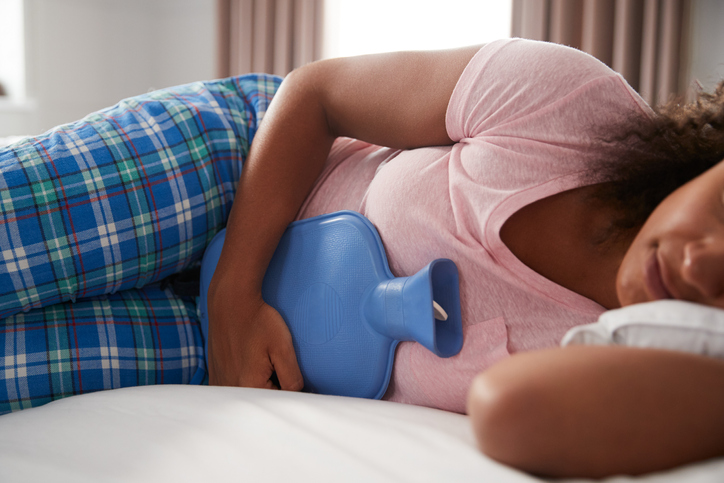What Causes Fibroids And What You Can Do About Them
Fibroids are common, and options offered are usually surgical or drug based. Oestrogen dominance is a factor and good progesterone levels can help.

Fibroids are common in women but most frequently found in those between 30-50.
At least 2 in 3 women will develop at least one fibroid at some point in their life. They may need no treatment and are linked to oestrogen dominance (excess oestrogen not balanced by progesterone) and become less common at menopause as oestrogen levels decline.
The weight gain at menopause can also be a factor as can exposure to forms of additional oestrogen such as HRT.
What are they?
Fibroids are round, firm, benign lumps on the muscular wall of the uterus, composed of smooth muscle and connective tissue, and seldom do you just get one.
In size they start small and grow to something the size of an orange, but can get much bigger.
For comparison a small fibroid is less than 1-5 cms in length (size of a pea to a cherry), a medium fibroid is 5cms -10cms (size of a plum to a large orange) and a large fibroid is 10cms or more (size of a grapefruit and above).
The most usual consequences are painful and/or irregular periods and heavy bleeding, often accompanied by pain.
Women with fibroids are often oestrogen dominant and have low progesterone levels. In women with smaller fibroids when progesterone is restored to normal levels, the fibroids often shrink and stop growing, which is due to progesterone’s ability to help speed up the clearance of oestrogen from the tissues.
However once a fibroid is large then no hormones should be used.
Symptoms of fibroids
Most women simply don’t notice if they have fibroids, as they don’t usually cause symptoms.
However, you may get one or more of the symptoms listed below, often depending on where the fibroid is within your womb:
* have heavy periods, sometimes leading to anaemia
* feel abdominal pain
* have swelling in your pelvic area
* pass urine more often than normal, or feel an urgent need to pass urine which happens if a fibroid is pressing on your bladder
* have constipation which happens if a fibroid is pressing on your bowel
What treatment is available?
If you don’t have any symptoms, or if your symptoms are mild, you won’t need treatment. But if you have more severe symptoms, there are a range of treatments you may be offered from drugs to IUD’s, the Pill and a range of surgical options.
When treating smaller fibroids you need to keep oestrogen levels as low as possible. When the fibroids have grown large, or are causing heavy bleeding, women are initially usually offered the contraceptive Pill or an IUD or Mirena coil.
All of these have drawbacks and Mirena is often believed to contain progesterone, but in fact has synthetic progestins which mimic the action of the hormone but is associated with a number of common side effects including stomach pain, dizziness, headache, nausea, breast tenderness and unusual tiredness or weakness.
You may also be offered surgical options such as these:
Uterine artery embolisation (UAE) This procedure blocks the blood supply to a fibroid, causing it to shrink and is done under a local anaesthetic.
Endometrial ablation or resection which removes most of the womb lining using energy such as microwaves or heat. Endometrial ablation is typically used for heavy menstrual bleeding, but is less successful with a large number of fibroids. During an endometrial resection, the lining of your womb or the fibroid is cut away.
Myomectomy is an operation that removes fibroids, but leaves your womb in place. It is usually only offered to women who would like the option to become pregnant in the future, but it is possible that more fibroids will grow and you may need further treatment.
Hysterectomy is a major operation to remove your entire womb, usually via a ‘bikini-line’ cut in your abdomen.
The bioidentical option
Fibroids tend to grow during the years before menopause and then shrink afterwards. This suggests that oestrogen stimulates fibroid growth, so rebalancing with bioidentical progesterone can help with the unopposed oestrogen that is stimulating their growth.
Women who are oestrogen dominant do appear to benefit from progesterone supplementation from Days 12-26 when still menstruating, or days 1-21 of the month if periods are irregular or stopped. Higher doses may be required initially to offset the oestrogen load.
Once menopause is under way the fibroids will begin to shrink naturally, but if you are around ten years or so away from your menopause you need to be aware that you are probably having anovulatory (non-ovulating) cycles and so you are producing much less progesterone than before but still the same amount of oestrogen.
Progesterone will not help to shrink very large fibroids and in fact with any large fibroid mass all hormone treatment should be avoided and discussed with your doctor.
Helpful information
Progesterone is certainly an important factor when dealing with fibroids but diet plays a part too.
Although progesterone levels drop at menopause, oestrogen continues to be made in the fat cells of the belly once the ovaries cease production – hence the common increase in weight gain around the middle.
If you would like some help, this article gives you some ideas.
https://anna.blog.wellsprings-health.com/9-dietary-changes-that-will-help-with-uterine-fibroids/


















